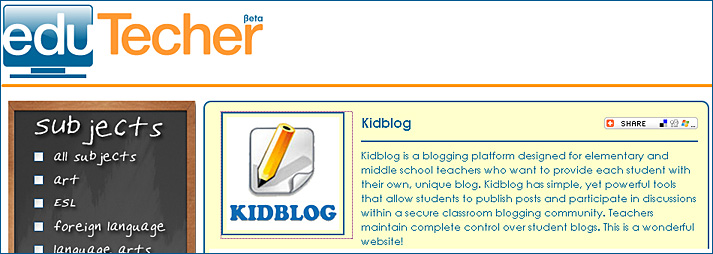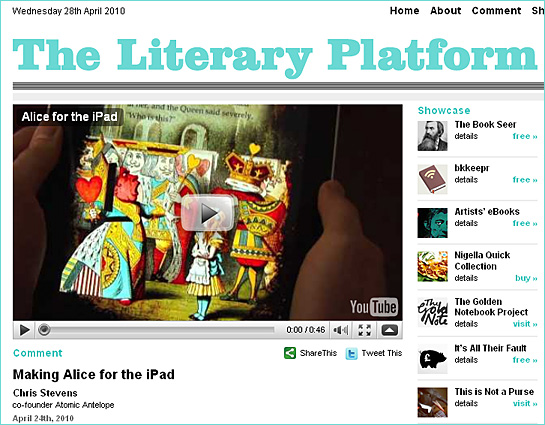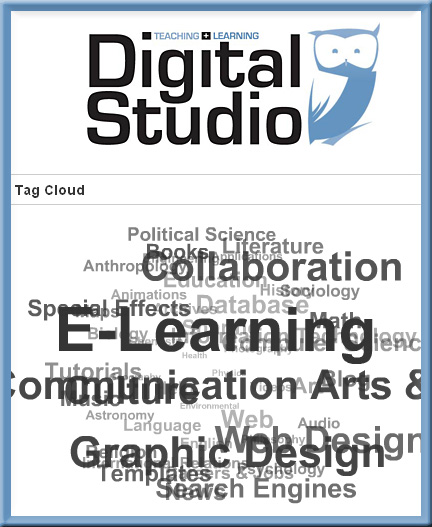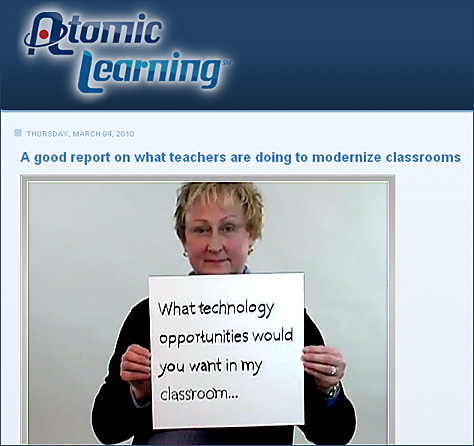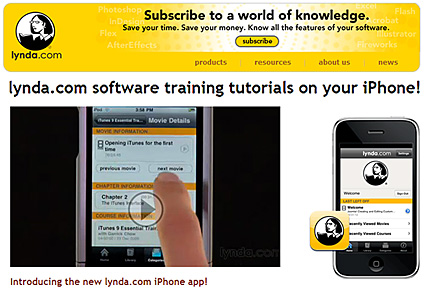Tips for teaching with blogs — Jason Rhode
I recently gave a talk at the UIC e-Teaching Symposium sharing practical tips for teaching with blogs. Here’s the video from the session recorded on a Flip HD pocket video camera along with the interactive handout in the form of a blog at uicblogs.blogspot.com. The Flip HD automatically stopped recording after 1 hour, so unfortunately the archive is missing the final 30 mins. of the talk
Blog ideas — from Dawn Corley
Ideas to incorporate the use of blogs with student learning
You can start a class blog with students to…
- post class-related information such as calendars, events, homework assignments and other pertinent class information
- post assignments based on literature readings and have students respond on their own blogs, creating a kind of portfolio of their work
- communicate with parents if you are teaching elementary school students
- post prompts for writing
- provide examples of classwork, vocabulary activities, or grammar games
- provide online readings for your students to read and react to
- gather and organize Internet resources for a specific course, providing links to appropriate sites and annotating the links as to what is relevant about them
- post photos and comment on class activities
- invite student comments or postings on issues in order to give them a writing voice
- publish examples of good student writing done in class
- show case student art, poetry, and creative stories
- create a dynamic teaching site, posting not only class-related information, but also activities, discussion topics, links to additional information about topics they are studying in class, and readings to inspire learning
- create a literature circle
- create an online book club
- make use of the commenting feature to have students publish messages on topics being used to develop language skills
- ask students to create their own individual course blogs, where they can post their own ideas, reactions and written work
- post tasks to carry out project-based learning tasks with students
- build a class newsletter, using student-written articles and photos they take
- link your class with another class somewhere else in the world
You can encourage your students (either on your blog using the comments feature or on their own blogs) to blog…
- their reactions to thought-provoking questions
- their reactions to photos you post
- journal entries
- results of surveys they carry out as part of a class unit
- share their ideas and opinions about topics discussed in class
You can have your students create their own blogs to…
- learn how to blog
- complete class writing assignments
- create an ongoing portfolio of samples of their writing
- express their opinions on topics you are studying in class
- write comments, opinions, or questions on daily news items or issues of interest
- discuss activities they did in class and tell what they think about them (You, the teacher, can learn a lot this way!)
- write about class topics, using newly-learned vocabulary words and idioms
- showcase their best writing pieces
You can also ask your class to create a shared blog to…
- complete project work in small groups, assigning each group a different task
- showcase products of project-based learning
- complete a WebQuest
- Share ideas you have for using blogs in education
As a teacher, you might want to use a blog as a reflective journal to…
- reflect on your teaching experiences
- keep a log of teacher-training experiences
- write a description of a specific teaching unit
- describe what worked for you in the classroom or what didn’t work
- provide some teaching tips for other teachers
- write about something you learned from another teacher
- explain teaching insights you gain from what happens in your classes
- share ideas for teaching activities or language games to use in the classroom
- provide some how-to’s on using specific technology in the class, describing how you used this technology in your own class
- explore important teaching and learning issues
For more foundational information, see:
What’s a blog?
Top 13 LMS (and learning technology) blogs — from UpsideLearning.com by Amit Gautam
More on reflective journals — from Learning Objects by Nancy Rubin
Reflective ‘writing’ is a series of ‘writings’ in response to experiences & events that may also contains reflections on what took place, express emotions, understandings & conclusions, lessons learned or action plans. Often called a “Journal Entry”. You don’t have to be a great writer, perfect speller, or creative thinker to keep a personal journal. Just regularly write down your experiences and thoughts. Here is a great video by Keuka College on the effectiveness of reflecting.
Click here to download an Academic Tip Sheet on Blogs and Journals (PDF) from Edith Cowan University.
Some Journal Prompts:
- Today I explored……………. and found………………..
- I think it is important to know about………..because…
- This new learning will affect me in the following ways…
- Today I discovered………. and…..
- With the learning I did today I will be able to…
- The most challenging thing I did today was…
- Today I found out…
- I want to know more about … and I will find out more by firstly…………….. then ………….. and perhaps…
- Today I asked… and discovered…
- The work we did today built on the work we did …..(insert time)….. in that it…(explain how) …………..,
- At the end of today I am still uncertain about… I get the bit about… but need to clarify the bit about…
- I smiled today when…
- Today I explored……. and feel……..
- more
Our Favorite Game Design Blogs — from Upside Learning Blog by Abhijit Kadle
Blogging then and now — from bloggingtips.com by Sharon Hurley Hall
“If you were starting a new blog today what’s the first thing you would do? I’ve just started a new blog and I started thinking about the difference between my first blog and this one. Here are some of the things I looked at…”
Resources for higher education management — from the Higher Education Management Group
Associations
- AACSB
- Assoc. of Research Managers and Administrators (UK)
- Assoc. of University Administrators (UK)
- CAUBO
- College Student Educators International (ACPA)
- Council of Higher Education Associations
- GUNI
- National Association of College & University Business Officers
- National Association of Financial Aid Administrators
- SCUP
Blogs
- AuthenticAssessment
- Beerkens Blog
- Career College Central
- Center for College Affordability
- Changing Higher Education
- Critical Mass
- Dr. Education (International Ed)
- Education Business
- Education Futures
- Educational Imaginations
- Enrollment Marketing
- Global Higher Ed
- Headway Strategies
- IHEC
- IMHE
- Institutional Performance
- Kevin Carey
- Knowledge Rules
- Ninth Level
- Open2Learn
- Personanondata
- Publishing 2.0
- Registrarism
- Scott Sommers
- The Cite
- The Other 85%
- University Business Blog
- Wallace Boston
- Wired Campus
College Management
- BridgePoint Education
- BrightStar Education Group
- EDMC
- Education Affiliates
- Eminata Group
- ForeFront Education
- Prospect Education
Consultants
- ABA
- Anthony Knerr
- Art & Science Group
- ASR Analytics
- Campus Management
- Ciber
- EdTek Services
- Educational Consulting Services
- Eduventures
- ETS
- Gilfus Education Group
- Hezel Associates
- Huron Consulting
- Illuminate Consulting Group
- Informed Education Group
- JM Associates
- Kaludis Consulting
- Keeling & Associates
- Michael G. Dolence
- Mind and Hand
- Oakleigh Consulting
- Prospectus
- Stevens Strategy
- Stillwater Group
- Strategic Initiatives
- Teresa Farnum
- The Advisory Board
- Voorhees Group
- Yardley Research Group
Content Providers
CRM
Development Consultants
- Ignitus Strategies
- Jerold Panas, Linzy, and Partners
- University Donor Software Solutions
- Witzleben Associates
Ed Tech Providers
Education Investment
- Berkery Noyes
- BMO Capital Markets
- Education Investment Forum
- Excellere Partners
- First Analysis
- Focus
- Knowledge Investment Partners
- Leeds Equity
- Legg Mason
- LLR Partners
- Parchman, Vaughan & Company
- Primus Capital
- RW Baird
- Signal Hill
- Vander Ark/Ratcliff
Education Statistics
Enrollment Management
- AACRAO
- Azorus
- ConnectEdu
- Datatel
- Edge
- Enrollment Rx
- Greenwood & Hall
- Hobsons
- iStrategy Solutions
- Maguire Associates
- Noel-Levitz
- SemWorks
- Student ROI
- SunGard
Full Service Companies
- 2Tor
- AcademyOne
- Collegiate Link
- Colloquoy
- Colloquoy360
- Higher Ed Holdings
- InterEd
- Presidium Learning
- Virtual-TA
Higher Ed Conferences
Higher Ed Journals
- Change
- Directory of Journals
- Distance Learning Administration
- Educause Review
- JALN
- OECD: HE Mgmt
- THE Journal
Higher Ed Law
Int’l Student Consulting
Lead Generation
LMS/CMS
- Angel Learning
- BlackBoard
- Desire2Learn
- (from DSC) Moodle
- Pearson eCollege
- xplana
Marketing Services
- Bob Johnson Consulting
- Deltak
- Edu Internet Strategies
- Education Branding
- Education Dynamics
- Educational Marketing Group
- Forward Analytics
- MarketingWorks
- MJD Consultancy
- Paskill Stapleton & Lord
- Simpson Scarborough
- SparkRoom
- Spectrum Edu Solutions
- Stamats
- Steven Messer Design
- Teresa Farnum
- The Lawlor Group
- Vander Ark/Ratcliff
- Wynne Communications
News Sources
- Academic Impressions
- ACE
- Converge (Magazine)
- Inside Higher Ed
- New York Times (Education)
- The Australian (Higher Education)
- The Chronicle of HE
- The Guardian (Higher Education)
- The Times Higher Education
- University Affairs
- University Business
- University World News
- W.Post Higher Ed
Outcome Measurement
Professional Development Firms
Proprietary Higher Ed
- American Public Education Inc.
- Argosy University
- BPP College
- Cardean University
- Devry University
- EDMC
- Excelsior University
- Kaplan University
- Laureate Education
- Lincoln Educational Services
- National College (PR)
- Piccolo University
- Rasmussen College
- Regis University
- Strayer University
- Think: Education Group
- University of Phoenix
Publishers
Research
- Cipher Systems
- Educational Policy Institute
- Eduventures
- Outsell Inc.
- Primary Research Group
- Slover Linett
- Sourcing Notes
- The Advisory Board
- Yardley Research Group
Search/Recruiters
- Academic Keys
- Academic Search
- Avondale Search
- Bert Davis
- College Executives
- Curran Career Services
- Ed-Exec
- EdRecruit
- EduSearch
- Heidrick & Struggles
- HERC National
- HigherEd Jobs
- Inside Higher Ed (Jobs)
- Kellen James
- Ligature Partners
- Network of Educators
- Personnel Associates
- Promeus Executive Search
- Royall and Company
- Scott Healy Associates
- Stanton Chase International
- Times UK (Jobs)
- University Business (Jobs)
- University World News (Jobs)
- UpsideJobs
- Virtus Search
- William Spelman Executive Search
Social Media Business
Student Portfolios
Student Retention
Technology Consulting
- Blackwell Consulting Services
- Collegiate Project Services
- DewPoint
- Gilfus Education Group
- Information Methodologies Inc.
- Informed Education Group
- io Consulting
- Moran Technology
- University Donor Software Solutions
- Vantage Technology Consulting Group
Think-Tanks









